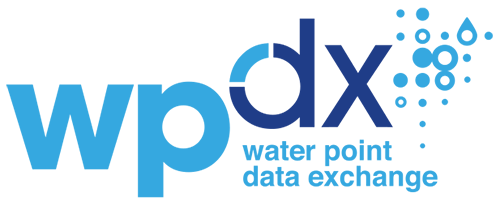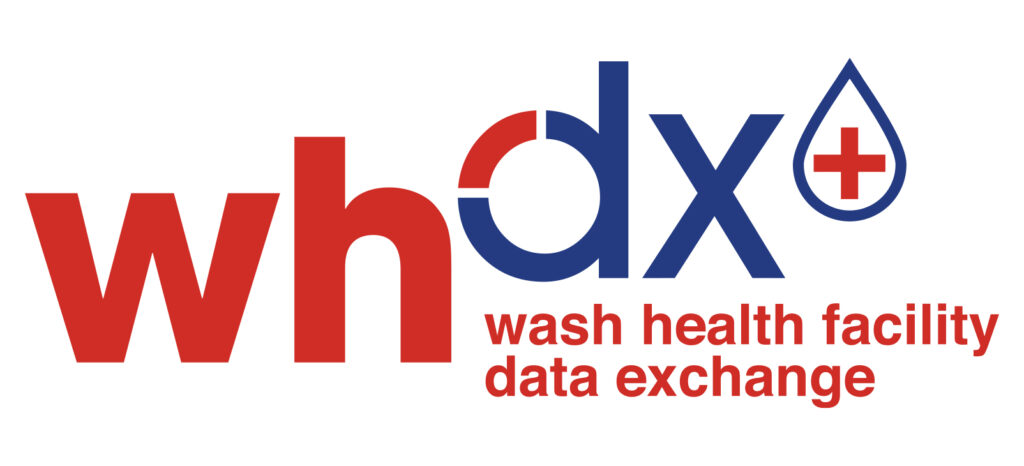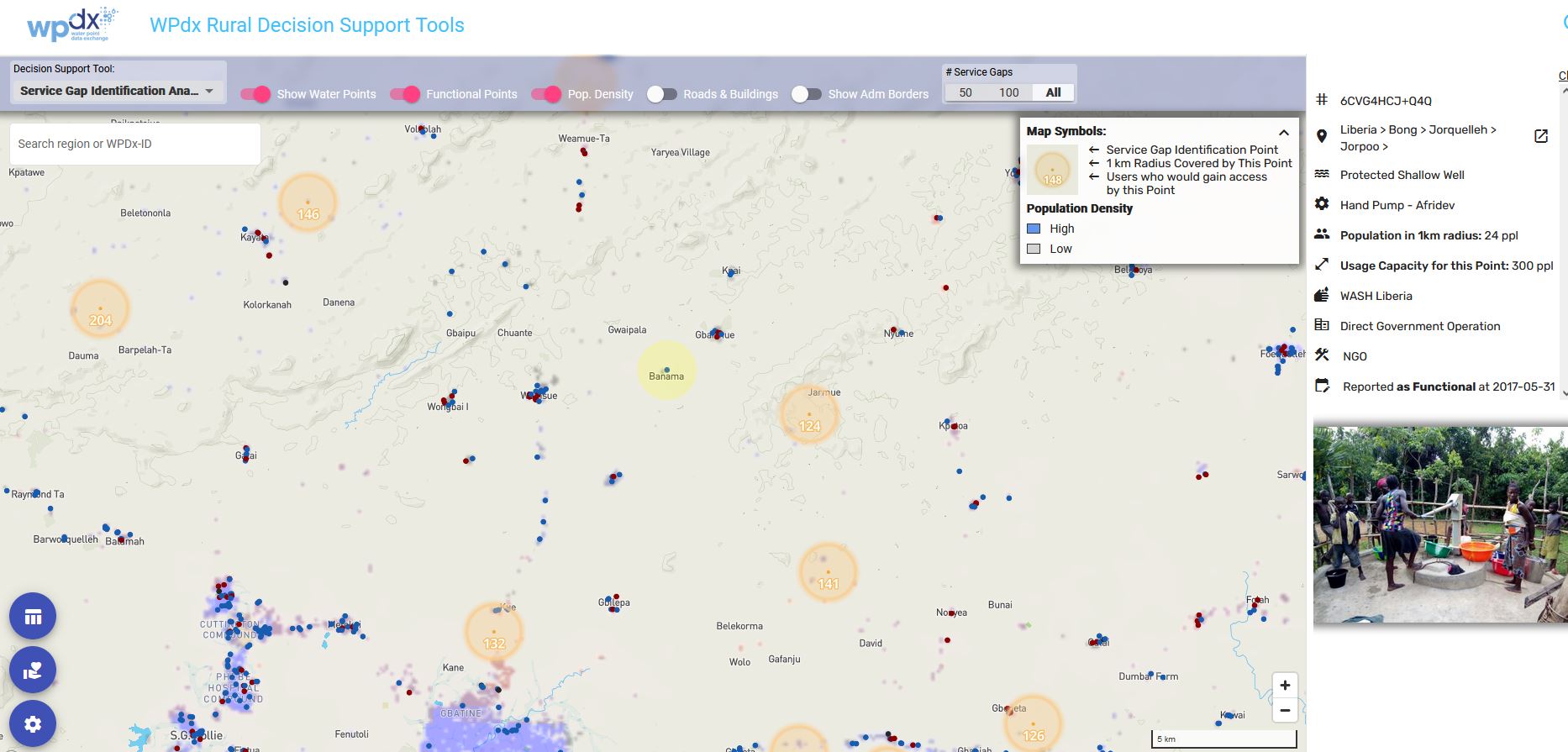
The Challenge: Dramatic acceleration needed to achieve SDGs
Today, 2 billion people lack access to safely managed drinking water services, including:
- 1.2 billion people with basic services
- 282 million with limited services
- 367 million using unimproved sources
- 122 million drinking surface water
According to the United Nations, at our current rate of progress, universal access to drinking water – Sustainable Development Goal 6 (SDG 6) – will not be reached and in 2030, hundreds of millions of people will still spend their days collecting potentially unsafe drinking water. A key impediment to progress is the lack of quality information about rural water services and infrastructure.
Many low- and middle-income countries do not have up-to-date national inventories of rural water services due to the costs of regularly collecting data at scale. While the use of smartphones, tablets, and sensors by governments, NGOs, academics and others to
Basic services are defined as drinking water which is available from an improved source, such as a protected well or spring, within a 30 minute round trip including time for queuing.
An estimated 20-34% of water points in sub-Saharan Africa may be non-functional at any one time (Foster et. al, 2019).
collect data is increasing the amount of information gathered, often the data is difficult to access and – as the datasets live on individual computers or organizational servers – inconsistently formatted, not publicly available, or shared with appropriate audiences. Where raw data is available, the capacity needed to turn it into insights to improve decisions is often limited. This means that critical decisions about water services are being made without sufficient information.
The Opportunity: The Water Point Data Exchange (WPdx)
To address these challenges, Global Water Challenge developed the Water Point Data Exchange (WPdx) in 2015 to gather diverse rural water data focused primarily on improving basic water services. WPdx is designed to leverage data already being collected by key stakeholders and provides a flexible upload process to compile and harmonize shared data in a variety of common formats.
WPdx hosts over 650,000 unique water point records from over 65 countries and 100 contributing organizations.
Governed by a working group of sector leaders, WPdx is funded by the Conrad N. Hilton Foundation and the Vitol Foundation.
The WPdx platform has three core components:
- SHARE: The WPdx Data Standard for data collection from individual water points or small water schemes;
- ACCESS: A cloud-based global data library enabling access to harmonized global data compliant with the WPdx Data Standard; and
- USE: A suite of decision support tools to guide policymakers and organizations to improve decision-making. Decision-support analyses are automatically run on a subset of data for countries which have nationally, or regionally representative data uploaded to WPdx.
Critical to the Decision Support Tools is understanding the population density around each water point. To accomplish this, WPdx uses Meta’s high resolution population density data as an application layer. The Data for Good Program at Meta makes this data available publicly on the Humanitarian Data Exchange and AWS for more than 160 countries and territories around the globe.
“High quality population data is critical to making the best possible estimates of potential water point users. This information is vital to identifying priorities to ensure programs are designed to reach the most vulnerable populations which may otherwise be left behind.”
~ Katy Sill, Ph.D., WASHdx Program Director Global Water Challenge
WPdx In Action
Across sub-Saharan Africa WPdx is being utilized to make critical financial and policy decisions about rehabilitating and building water facilities. A recent desk study demonstrated that compared to traditional approaches, using WPdx tools can more effectively prioritize unserved populations resulting in four times as many people being reached with a third less resources. In the Sierra Leone case study, this equated to a per-person-reached cost reduction from $54.66 to $3.94.
In Ethiopia, the Millennium Water Alliance (MWA) has been implementing a five-year Water, Sanitation and Hygiene (WASH) Program in Dera, Farta and North Mecha woredas (districts) in the Amhara National Regional State (ANRS) since April 2019. With funding support from the Conrad N. Hilton Foundation, MWA and its program partners have prioritized water supply monitoring systems as one of the key program pillars. In 2020 WPdx was integrated into the programas a platform to compile updated government and NGO water point data to track SDG progress and support evidence-based decisions.
“The critical challenges in data management are scarcity, poor quality, and availability in different formats which are not easily usable.”
~Tilik Tena, Researcher & Lecturer Bahir Dar Institute of Technology Bahir Dar University
Since then, over 20,000 water point records from over 10 leading organizations have been uploaded and harmonized. The three target districts have a population of over 600,000 people, and there are plans to expand the use of WPdx across the Amhara region, home to over 20 million people.
So far, results from the WPdx decision support tools have been used by MWA and partners to
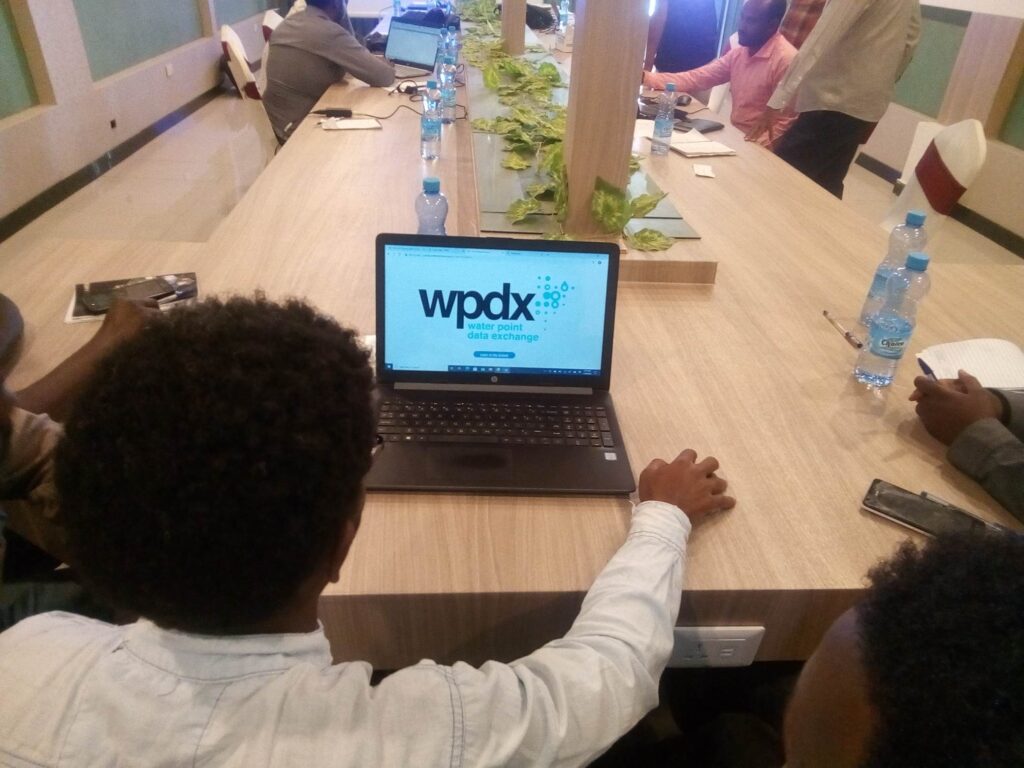
prioritize investments. For instance, during the WASH program Annual Reflection and Learning Workshop, the tools compared the potential impact of existing water point rehabilitation versus resource allocation for the new water point construction. According to the government’s guidelines, water point rehabilitation must be done by user communities and NGOs are not advised to intervene in maintenance and rehabilitation.
However, by using the WPdx Rehabilitation Priority tool (which utilizes Meta’s high resolution population density data) to conduct a detailed analysis of the population that would benefit from new water supply system construction versus rehabilitation provided a convincing justification for the inclusion of water point rehabilitation support as core to the implementation plans.
“The role of Meta/Facebook in bringing people together across the different margins of the world to help look at one shared window is a phenomenal discovery. Its involvement in the WPdx platform which brings thousands of water point data together for learning-exchange, prediction and hence efficient management of scarce resources is another layer towards villagizing of the world. I am thrilled both by what has been done so far in Ethiopia to help decision makers start utilizing WPdx and also in the magnificent potential that WPdx platform brings to bridging the data management bottleneck in the WASH sector in Ethiopia.”
~Tedla Mulatu, Country Director Millennium Water Alliance Ethiopia
In Sierra Leone, through the establishment of the national Digital Monitoring Strategy and associated government directives, WPdx Decision Support Tools have been institutionalized across all water agencies. District Water Offices in Bombali and Port

Loko districts (home to over 1,000,000 people) utilize the tools to inform work plans including the locations for water point rehabilitation and new construction. The Ministry of Water Resources is working with district water engineers and mapping officers to expand active use of WPdx to other districts. Priority locations are ranked by the number
of people potentially served by rehabilitated and/or new water points, estimated by using Meta’s high resolution population density dataset. Two population figures are calculated for each water point: a) number of people who live within a 1km radius from the water point (proxy for ‘basic water services’ definition per the UN/WHO Joint Monitoring Programme) and b) number of potential/likely users based on population and locations of other nearby water points.
“Before WPdx, the selection of the location of water points was done by assumption and political decisions. Today, our district planning officers and national budget officers are using WPdx tools to reduce duplication and improve resource allocation in the country.”
~Mohamed Bah, Head of Monitoring & Evaluation Sierra Leone Ministry of Water Resources
In Uganda, WPdx is partnering with USAID and YouthMappers to demonstrate the benefits of digitizing water point data collection. In collaboration with Gulu University and the Gulu YouthMappers chapter over 600 water point records, serving close to 10,000 people, were collected using KoboCollect, a customizable open-source
application used for primary data collection in humanitarian emergencies and other challenging circumstances. Data uploads to the WPdx platform were automated daily to provide an up-to-date view of the effort. The results of the data collection effort can be seen through the Administrative Region Analysis tool, which estimates the number of people with access to
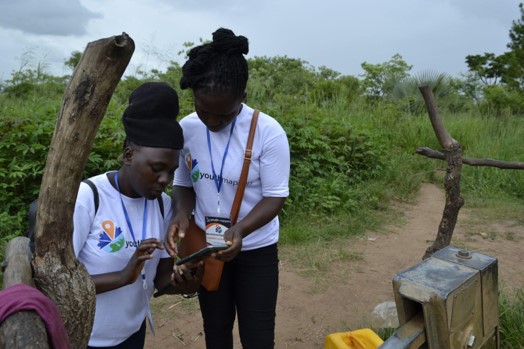
functional and non-functional water points.
The analyses from the WPdx Decision Support Tools were shared with government, NGO and academic stakeholders who expressed interest in how the process could be used to more effectively collect and use water point data to improve service access. Discussions about a regional or national scaling of the effort to track progress towards the SDGs are ongoing.
“The U-WIMP project demonstrated how digitizing data collection allows information to be more rapidly shared compared to traditional paper-based methods. The WPdx platform helps to bring this data together and provides rapid analyses and visualizations to help provide a better understanding of the populations which currently have or lack access to available basic water services.”
~Courtney Clark, Program Director Everywhere She Maps, YouthMappers
Expanding to focus on WASH in Health Care Facilities
While WPdx continues to support programs in these and other countries a new platform, the WASH in Health Facilities Data Exchange (WHdx) will be launched this year with similar datasets and tools to help accelerate improved WASH services at health care facilities around the world.
Overview of WPdx Decision Support Tools
This section provides a brief summary of the WPdx decision-support tools used in the impact stories above.
View Water Points – provides an overview of available information for all water point records in WPdx. Also provides details for specific water points, including the point source, technology, location, and population within 1km of the water point.
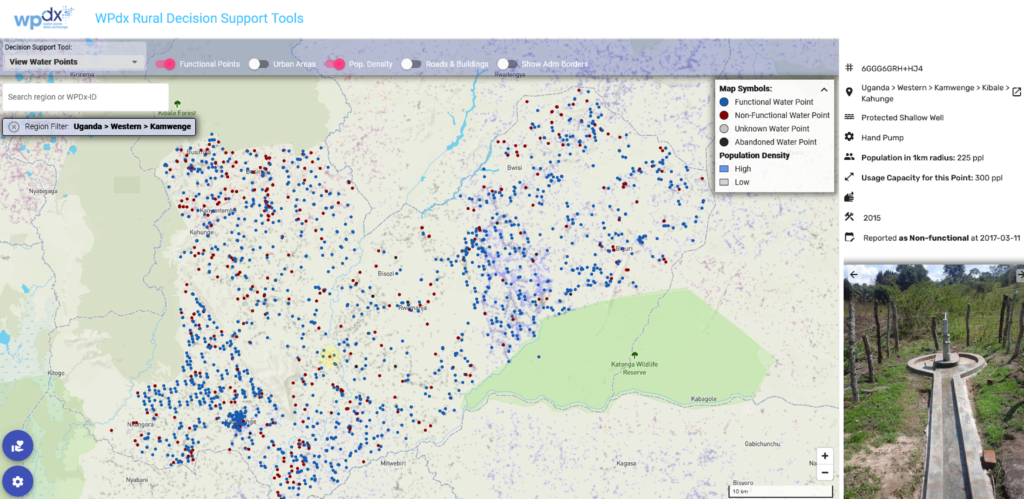
Administrative Region Analysis – provides overview of the served, unserved, and uncharted populations for each available administrative division. Summarizes the distribution of water point source, technology, management type and installation years for a specific administartive region.
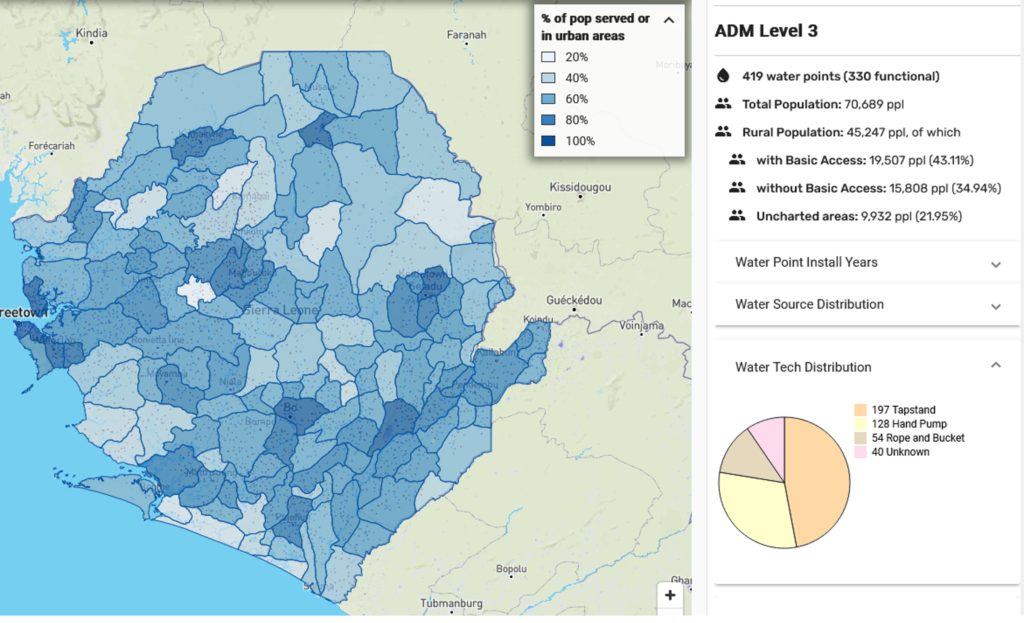
Rehabilitation Priority Analysis – provides ranked recommendations for the repair of non-functional water points to reach currently unserved populations. Estimates likely users per point based on population estimates and the proximity of other water points.
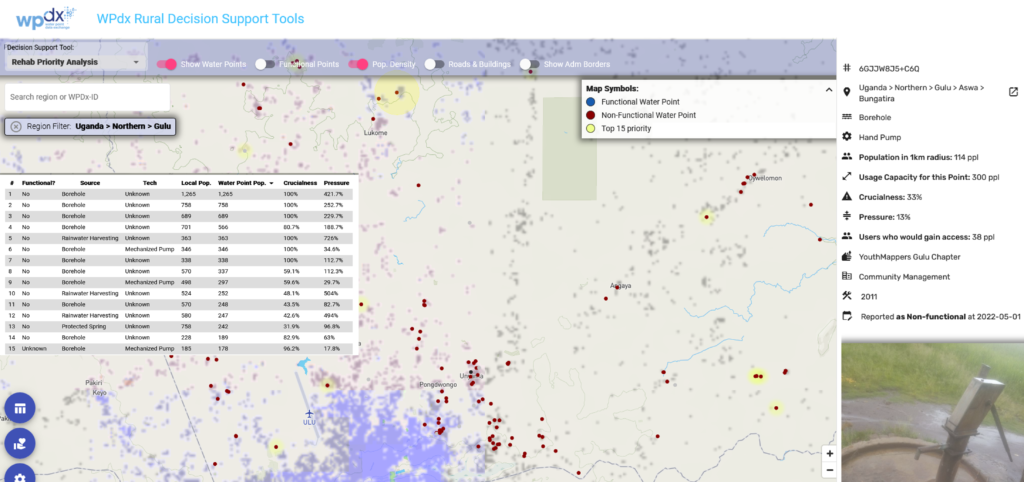
Service Gap/New Construction Priority Analysis – identifies locations for new service installation not within 1km of existing water points. Locations are ranked by the number of unserved people within 1km of the proposed locations. The tool may also provide insights on potential data gaps.
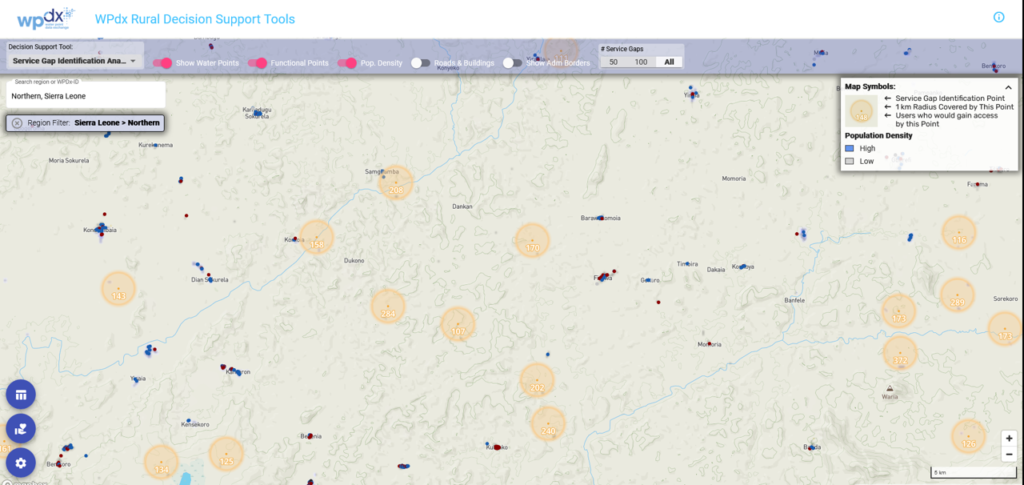
Data Quality Analysis – qualifies available data based on the age of available water point data and the coverage in terms of the percent of the total population living within 1km of water points included in the dataset on both point and administrative division scales.
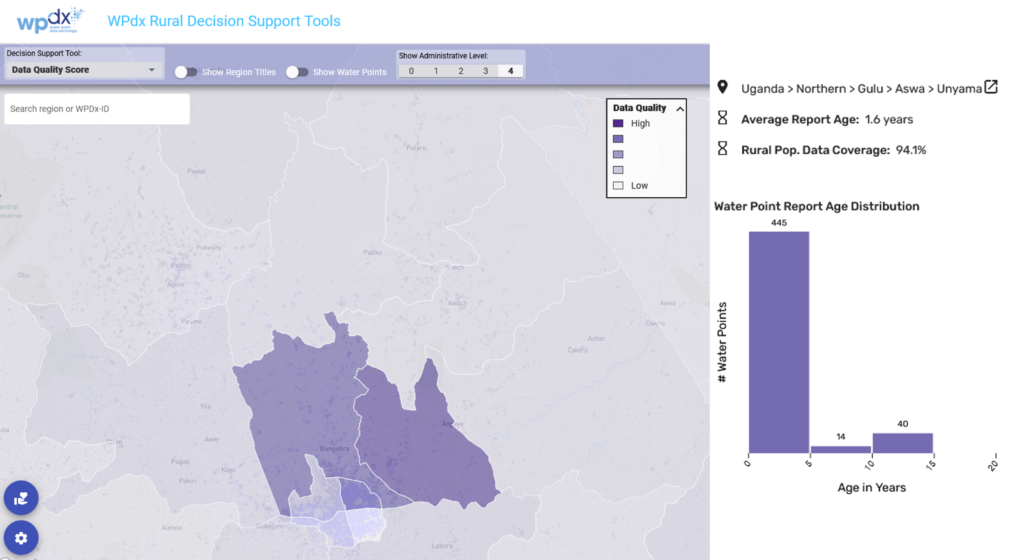
Status Prediction Analysis – A new WPdx prediction model will soon be released to identify water points at highest risk of failure. The model utilizes data shared via the WPdx platform, population-based parameters calculated by WPdx, and external data which provides context for the environmental and demographic conditions around the water point. These external datasets include demographic data from Meta’s high resolution population density data as well as the Meta’s Relative Wealth Index.
For more information on WPdx or WHdx, please contact info@waterpointdata.org.
Global Water Challenge is a coalition of leading organizations deploying expertise and networks to achieve universal access to safe and affordable drinking water, sanitation, and hygiene (WASH) in communities around the world. Since 2006, GWC has positively impacted more than 2 million people across Africa, the Americas and Asia with clean water access. GWC’s actionable insight and innovative programs provide critical sector tools, data and best practices to reach millions more. With multi-sector partners, GWC engages for action – catalyzing financial resources and driving innovative programming for sustainable, local solutions.
The Data for Good at Meta program provides privacy protecting data to assist in disaster response, health crises, poverty alleviation, and climate change. Eligible nonprofits and universities can apply for access to data on their website www.dataforgood.facebook.com.
